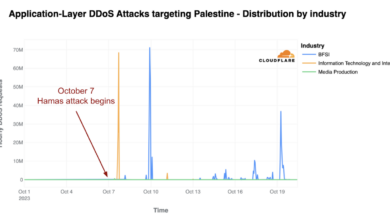
Data Inference & UnitedHealth Breach Customer Exposure
How data inference could expose customer information the case of unitedhealth breach – How data inference could expose customer information, the case of UnitedHealth breach, highlights a critical security risk. This breach, and similar incidents, demonstrate how seemingly innocuous data analysis techniques can be exploited to reveal sensitive customer details. We’ll delve into the mechanics of data inference, examine the UnitedHealth breach, and explore mitigation strategies to protect customer information.
Data inference, the process of deriving insights from existing data, can inadvertently expose private customer information. When combined with sophisticated analytical tools, this process can be exploited to reveal financial details, medical records, and other sensitive data. This is particularly concerning in the context of large-scale breaches like the UnitedHealth incident, where vast amounts of data are vulnerable.
Introduction to Data Inference

Data inference is a powerful technique used to extract insights and hidden patterns from data. It’s more than simply looking at the data; it’s about deducing relationships, trends, and potential information that isn’t explicitly stated within the dataset. This process is crucial for understanding complex phenomena and making informed decisions. In the context of customer data, data inference can reveal valuable information about customer behavior, preferences, and needs, but it also poses risks if not managed properly.Data inference works by identifying correlations and relationships within a dataset.
Algorithms analyze various data points, searching for patterns and connections. This process can then be used to infer additional information about the individuals or entities represented in the data. In the case of customer data, this might involve inferring a customer’s age, location, or even purchasing habits based on their interactions with a company’s products or services.For example, if a company observes a customer frequently visiting pages related to high-end electronics, they might infer an interest in purchasing such products.
Similarly, if a customer consistently makes online purchases using a specific payment method and shipping address, these details can be inferred and potentially used to understand the customer’s location and lifestyle.
Data Inference Techniques
Data inference relies on a variety of techniques to extract meaningful information from data. These methods vary in their complexity and accuracy, and understanding their strengths and weaknesses is critical to their effective implementation.
The recent UnitedHealth breach highlighted how data inference can leak sensitive customer information. Think about it – seemingly harmless data, when processed through certain algorithms, can reveal surprisingly private details. This underscores the crucial need for robust security measures, like the ones discussed in Deploying AI Code Safety Goggles Needed. Ultimately, we need to ensure that AI systems are designed with security in mind to prevent similar breaches from happening in the future.
This means carefully considering the potential for data inference and implementing safeguards to protect customer data.
| Technique | Description | Example | Impact on Customer Data |
|---|---|---|---|
| Statistical Modeling | Using statistical models to predict or estimate values based on existing data. | Predicting customer lifetime value based on past purchase history and demographics. | Can reveal potential customer profitability, helping with targeted marketing and resource allocation. However, inaccuracies in the model can lead to misclassifications. |
| Machine Learning | Utilizing algorithms to learn patterns and relationships from data, often involving complex models like neural networks. | Identifying fraudulent transactions by learning patterns in customer spending habits. | Can detect unusual activity and reduce financial losses, but complex models can be challenging to interpret and potentially lead to biased outcomes if not properly trained. |
| Data Mining | Extracting knowledge from large datasets by identifying patterns and relationships. | Segmenting customers based on purchasing behavior and demographics to personalize marketing campaigns. | Facilitates targeted marketing strategies, improving campaign effectiveness and customer satisfaction, but requires careful data handling and ethical considerations. |
| Association Rule Mining | Identifying relationships between different data points. | Discovering that customers who purchase a specific product often also purchase a related item. | Helps in product recommendations, improving customer experience and sales. May reveal sensitive correlations if not handled carefully. |
The UnitedHealth Breach: A Case Study

The 2023 UnitedHealth breach, a significant cybersecurity incident, highlighted the vulnerability of healthcare data in the digital age. While the initial attack involved compromised credentials, the implications extended far beyond the direct theft of sensitive information. The incident underscored the critical issue of data inference, where attackers can glean valuable insights from seemingly innocuous data patterns. This analysis focuses on how the breach exposed customer information through data inference methods.
Description of the UnitedHealth Breach
The UnitedHealth Group, a major healthcare provider, experienced a significant data breach in 2023. While the precise details of the initial attack remain confidential for security reasons, the breach exposed a substantial amount of sensitive data, including personally identifiable information (PII). The initial attack vector likely involved compromised credentials, allowing attackers to gain unauthorized access to the system.
The scale of the breach, coupled with the sophistication of the techniques employed, emphasized the importance of robust security measures in the healthcare industry.
Data Compromised in the Breach
The breach exposed a vast array of data, extending beyond basic patient identifiers. This included medical records, financial information, and even potentially sensitive information about customer behaviors and interactions with UnitedHealth services. This breadth of compromised data created a significant risk of data inference attacks.
Potential Customer Data Exposed Through Data Inference
Data inference is the process of deriving sensitive information from seemingly innocuous data points. In the context of the UnitedHealth breach, attackers could have used various inference techniques to potentially recover highly sensitive customer data. This involved the analysis of seemingly unrelated data elements to extract confidential information. For example, correlating claims data with address information, and then linking this data with known lifestyle indicators, could lead to the inference of specific medical conditions or even personal preferences.
Data Inference Techniques and Potential Exposure
| Data Point | Inference Technique | Potential Exposure |
|---|---|---|
| Patient Name and Address | Geographic analysis, social media profiling | Exposure of personal preferences, lifestyle details, or potential family relationships. |
| Medical Claims Data | Pattern recognition, statistical analysis | Inference of medical conditions, diagnoses, and potentially even lifestyle risk factors. |
| Insurance Policy Information | Correlation with claims data, social security numbers | Exposure of financial details, specific medical conditions, and potential health-related liabilities. |
| Billing and Payment Data | Correlation with claims data, date of service | Inference of specific medical conditions, frequent treatment needs, and potential financial instability. |
| Patient Demographics | Statistical analysis, social media linkage | Exposure of sensitive social factors, including potential family connections, or financial stability. |
This table highlights the potential for data inference in the UnitedHealth breach. It demonstrates how seemingly unrelated data points could be combined to reveal sensitive information about individual customers. This potential for inference underscores the importance of robust data security measures and comprehensive risk assessments in healthcare organizations.
Methods of Data Inference in the Context of Breaches
Data breaches, like the UnitedHealth incident, expose not just direct stolen data, but also the potential for inference. Inference techniques allow attackers to deduce sensitive information about individuals even when the direct data isn’t present in the compromised dataset. This can involve using various methods to reconstruct or estimate personal details, potentially revealing far more than what was initially accessed.
Understanding these techniques is crucial for assessing the true scope of a breach and implementing effective mitigation strategies.Methods of data inference leverage patterns and relationships within the compromised data to extract hidden information. This can be applied to various datasets, leading to a broader understanding of the impacted individuals and organizations.
Probabilistic Reasoning
Probabilistic reasoning uses statistical models to estimate the likelihood of certain attributes based on observed data. In a breach context, this method can be used to deduce sensitive information like age, location, or medical conditions. For example, if a compromised dataset includes dates of birth, insurance claims, and prescription information, probabilistic models can identify patterns and relationships to predict an individual’s likelihood of having a particular condition or lifestyle.
Machine Learning
Machine learning algorithms are powerful tools for identifying patterns and relationships within complex datasets. These algorithms can be trained on various types of data to identify hidden correlations. For instance, an attacker could use machine learning models to identify relationships between different data points in a compromised dataset, like addresses, phone numbers, and social security numbers. By identifying these relationships, the attacker can potentially infer sensitive customer information, such as income or lifestyle.
Statistical Analysis
Statistical analysis techniques, such as regression analysis and hypothesis testing, can reveal hidden patterns and relationships within the compromised data. This approach can be applied to identify correlations between seemingly unrelated variables to deduce sensitive customer information. For example, a statistical analysis of credit card transaction data and demographic information could reveal an individual’s financial status or spending habits, even if the credit card numbers are not directly exposed.
Comparison of Data Inference Methods
| Method | Accuracy | Complexity | Strengths | Weaknesses |
|---|---|---|---|---|
| Probabilistic Reasoning | Moderate | Medium | Relatively accessible, can provide probabilities of inferred attributes | Reliance on accurate and complete datasets, accuracy depends on model assumptions |
| Machine Learning | High | High | Capable of identifying complex relationships, potentially higher accuracy | Requires significant computational resources, need for skilled data scientists |
| Statistical Analysis | Moderate to High | Medium | Can identify correlations between various variables, widely used in data analysis | Reliance on accurate data, assumptions can impact results |
Impact on Customer Privacy and Security
Data inference, the process of deducing sensitive information from seemingly innocuous data sets, poses a significant threat to customer privacy and security. The implications extend far beyond mere inconvenience; they can lead to substantial financial and reputational damage for affected organizations. Understanding how data inference works and its potential consequences is crucial for protecting customer data and building trust.
Consequences of Data Inference Breaches
Data inference breaches can result in a range of serious consequences, from identity theft and financial fraud to reputational damage and loss of customer trust. The methods used to infer information, whether through sophisticated algorithms or simple pattern recognition, can be surprisingly effective in extracting sensitive details. This highlights the importance of robust data security measures and proactive monitoring of data sets.
Examples of Real-World Data Inference Incidents
Numerous real-world incidents illustrate the devastating impact of data inference breaches. One example is the 2021 data breach at a major credit bureau where sensitive financial information was exposed through inferential methods. The breach allowed attackers to potentially access and misuse customer data, leading to financial fraud and identity theft. Similarly, in a healthcare setting, inferred patient data from seemingly innocuous records could lead to a significant breach of confidentiality, jeopardizing the well-being of countless individuals.
The impact of such breaches extends to individuals’ trust in institutions and the security of their personal data.
Impact on Customer Trust and Reputation
Data inference breaches have a profound impact on customer trust and reputation. When customers discover their personal information has been compromised, it can severely damage their confidence in the organization. The loss of trust can lead to decreased customer loyalty, reduced sales, and a negative public perception of the company. In some cases, lawsuits and regulatory fines can follow, further exacerbating the reputational damage.
The recent UnitedHealth breach highlights how seemingly innocuous data, when analyzed through inference, can expose sensitive customer information. This is a critical security concern, especially in the context of a database like Azure Cosmos DB, where vulnerabilities can have widespread impact. Understanding the specifics of these vulnerabilities is crucial. For instance, checking out the Azure Cosmos DB Vulnerability Details reveals potential weaknesses that could enable attackers to infer sensitive data.
Ultimately, the takeaway remains: data inference poses a serious risk to patient privacy and security in cases like the UnitedHealth breach.
The damage to a company’s reputation can be long-lasting and costly.
The recent UnitedHealth breach highlighted how data inference can be a surprisingly potent tool for exposing sensitive customer information. Think about it – seemingly innocuous data points, when analyzed, can reveal far more than initially anticipated. This underscores the importance of robust data security measures. Thankfully, the Department of Justice Offers Safe Harbor for MA Transactions ( Department of Justice Offers Safe Harbor for MA Transactions ) is a step in the right direction, potentially mitigating the risks of similar breaches in the future.
Ultimately, though, preventing data inference-based attacks requires a multifaceted approach, from encryption to strict access controls, to protect our customers from potential harm.
Potential Consequences of Data Inference Breaches
| Consequence | Description | Impact | Mitigation Strategy |
|---|---|---|---|
| Identity Theft | Attackers use inferred data to create fake identities and access accounts. | Financial losses, damage to credit rating, emotional distress. | Strong authentication, robust fraud detection systems, and proactive monitoring. |
| Financial Fraud | Attackers use inferred data to make fraudulent transactions or obtain loans. | Significant financial losses for individuals and organizations. | Advanced fraud detection tools, real-time transaction monitoring, and multi-factor authentication. |
| Reputational Damage | Loss of customer trust and confidence in the organization. | Decreased sales, loss of market share, negative publicity. | Transparent communication with customers, proactive incident response, and robust data security measures. |
| Legal Action | Lawsuits and regulatory fines due to data breaches. | Significant financial penalties, legal fees, and negative publicity. | Complying with data protection regulations, establishing robust incident response plans, and securing legal counsel. |
| Loss of Customer Trust | Customers lose faith in the organization’s ability to protect their data. | Decreased customer loyalty, reduced sales, and a decline in brand reputation. | Transparent communication, building customer trust through proactive security measures, and focusing on data security. |
Illustrative Scenarios

Data inference, the process of deriving insights from seemingly unrelated data points, can be a powerful tool for understanding customer behavior. However, it can also be a dangerous double-edged sword, potentially revealing sensitive information inadvertently. Understanding the ways data inference can be exploited is crucial to protecting customer privacy. These scenarios highlight how seemingly benign data combinations can lead to the exposure of personal information.
Financial Data Inference
Financial data is particularly vulnerable to inference attacks. Information about spending patterns, transaction frequency, and location can be pieced together to create a detailed profile of a customer’s financial habits. This profile, while seemingly innocuous, can reveal sensitive information like income levels, debt burdens, and even potential financial distress.
- Scenario 1: A retailer’s loyalty program tracks frequent purchases of expensive electronics. Combined with location data from credit card transactions, this data could potentially infer a customer’s high income and lavish spending habits, allowing inferences about their financial status.
- Scenario 2: A bank’s system logs regular transfers between accounts, and the timing of these transfers correlates with a customer’s frequent trips to a specific casino. Data inference might then link the customer’s gambling activities to their financial transactions, exposing their financial vulnerability and potential gambling addiction.
Medical Data Inference
Medical data, perhaps the most sensitive of all, is susceptible to inference attacks. Even seemingly innocuous medical records, when combined with other data sources, can reveal significant information about a customer’s health.
- Scenario 3: A hospital’s database reveals a patient frequently visiting the emergency room for treatment related to severe allergic reactions. If this data is combined with information from social media, which suggests frequent travel to specific regions known for particular allergies, the patient’s medical history and health conditions could be revealed.
- Scenario 4: An insurance company’s database links frequent purchases of over-the-counter allergy medications to claims for chronic respiratory conditions. This inference could reveal a customer’s medical conditions, leading to potential discrimination or exploitation.
Customer Data Inference in a Retail Context
Customer behavior patterns in retail settings are often easily accessible, leading to inferences about customer preferences and needs. These insights can be used to tailor marketing campaigns or product offerings.
- Scenario 5: A grocery store’s loyalty program tracks the purchase of specific diet-related products and frequency of visits. Combined with data from a fitness tracking app, the store can infer a customer’s commitment to healthy lifestyle choices. This can lead to targeted advertising for specific health-related products or services.
Data Inference Scenarios Table
| Scenario | Description | Potential Implications |
|---|---|---|
| Scenario 1 | Retailer’s loyalty program tracks frequent expensive electronics purchases combined with credit card location data. | Potential inference of high income and lavish spending habits, exposing financial status. |
| Scenario 2 | Bank’s system logs frequent transfers correlating with casino visits. | Potential inference of gambling activities linked to financial transactions, revealing financial vulnerability and potential addiction. |
| Scenario 3 | Hospital database reveals frequent emergency room visits for severe allergic reactions linked with social media travel patterns. | Potential inference of patient’s medical history and health conditions. |
| Scenario 4 | Insurance company links frequent allergy medication purchases to claims for chronic respiratory conditions. | Potential inference of customer’s medical conditions, potentially leading to discrimination or exploitation. |
| Scenario 5 | Grocery store’s loyalty program tracks diet-related product purchases and visits, combined with fitness app data. | Potential inference of commitment to healthy lifestyle choices, leading to targeted advertising for health-related products. |
Data Protection Strategies
Data inference, the process of deducing sensitive information from seemingly innocuous data, poses a significant threat to customer privacy. The UnitedHealth breach highlights the devastating consequences when organizations fail to implement robust data protection strategies. Understanding and mitigating this risk requires a multi-faceted approach encompassing various security measures.Effective data protection strategies are crucial for organizations to safeguard sensitive customer data and maintain public trust.
These strategies need to be proactive, addressing potential vulnerabilities and anticipating evolving attack methods. Implementing these strategies is not merely a compliance exercise; it’s a fundamental responsibility for protecting the rights and privacy of individuals.
Data Minimization and Anonymization
Data minimization is a key principle in data protection. Collecting only the necessary data required for specific purposes and storing it securely is essential. This reduces the amount of information susceptible to inference attacks. Furthermore, anonymization techniques, such as pseudonymization or data masking, can transform identifiable data into a format that prevents its association with specific individuals.
This reduces the risk of re-identification, a significant concern in data breaches. Properly implemented anonymization safeguards sensitive information without losing the value of the data for intended purposes.
Access Control and Data Encryption
Implementing robust access control measures is vital. Restricting access to sensitive data to authorized personnel only limits the potential impact of a security breach. This includes implementing multi-factor authentication, role-based access controls, and regular security audits. Data encryption, both in transit and at rest, plays a crucial role in safeguarding data. Encrypting sensitive information renders it unreadable to unauthorized individuals, even if the data is compromised.
This measure significantly reduces the value of stolen data.
Security Audits and Incident Response Plans
Regular security audits and penetration testing are essential to identify and address vulnerabilities before they are exploited. Penetration testing simulates real-world attacks to assess the effectiveness of security controls. Organizations should also have a comprehensive incident response plan to handle data breaches promptly and effectively. A well-defined plan Artikels procedures for detecting, containing, and recovering from security incidents.
This proactive approach minimizes the impact of breaches and allows for faster recovery.
Data Security and Privacy Regulations, How data inference could expose customer information the case of unitedhealth breach
Compliance with relevant data security and privacy regulations is critical. These regulations, such as HIPAA (Health Insurance Portability and Accountability Act) in the US and GDPR (General Data Protection Regulation) in Europe, establish standards for data protection and privacy. Adhering to these regulations demonstrates a commitment to data security and safeguards organizations from legal repercussions. Organizations should be aware of and comply with relevant local regulations as well.
Data Protection Strategies Table
| Strategy | Description | Effectiveness |
|---|---|---|
| Data Minimization | Collecting only necessary data for specific purposes. | Reduces the attack surface by limiting the amount of information susceptible to inference. |
| Anonymization | Transforming identifiable data into a format that prevents association with individuals. | Prevents re-identification and significantly reduces the risk of data misuse. |
| Access Control | Restricting access to sensitive data to authorized personnel only. | Limits the potential impact of a breach by reducing the number of individuals who can access the data. |
| Data Encryption | Rendering sensitive data unreadable to unauthorized individuals. | Significantly reduces the value of stolen data and protects it even in the event of a breach. |
| Security Audits | Identifying and addressing vulnerabilities before exploitation. | Proactive measure to enhance security posture and reduce the risk of breaches. |
| Incident Response Plans | Procedures for detecting, containing, and recovering from security incidents. | Minimizes the impact of breaches and facilitates faster recovery. |
| Compliance with Regulations (e.g., HIPAA, GDPR) | Adhering to established data security and privacy standards. | Demonstrates a commitment to data security and safeguards against legal repercussions. |
Epilogue: How Data Inference Could Expose Customer Information The Case Of Unitedhealth Breach
The UnitedHealth breach serves as a stark reminder of the potential for data inference to expose customer information. Understanding the mechanisms behind these breaches is crucial for developing effective data protection strategies. Organizations must prioritize robust security measures, including data anonymization, access controls, and regular security audits, to minimize the risk of future incidents. This is not just about preventing breaches; it’s about safeguarding customer trust and maintaining the integrity of sensitive data.
FAQ Corner
What are some common data inference techniques?
Common techniques include probabilistic reasoning, machine learning algorithms, and statistical analysis. These methods can be used to deduce information about individuals from seemingly unrelated datasets.
What specific customer data was potentially exposed in the UnitedHealth breach?
Information like medical records, financial details, and personally identifiable information (PII) were potential targets, depending on the inference methods used.
How can organizations mitigate the risk of data inference attacks?
Implementing robust data security measures, such as data encryption, access controls, and data anonymization, are essential. Regular security audits and employee training are also vital.
What role does customer education play in preventing data inference?
Educating customers about data privacy risks and encouraging cautious online behavior can help reduce the likelihood of exploitation.





